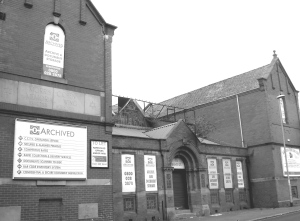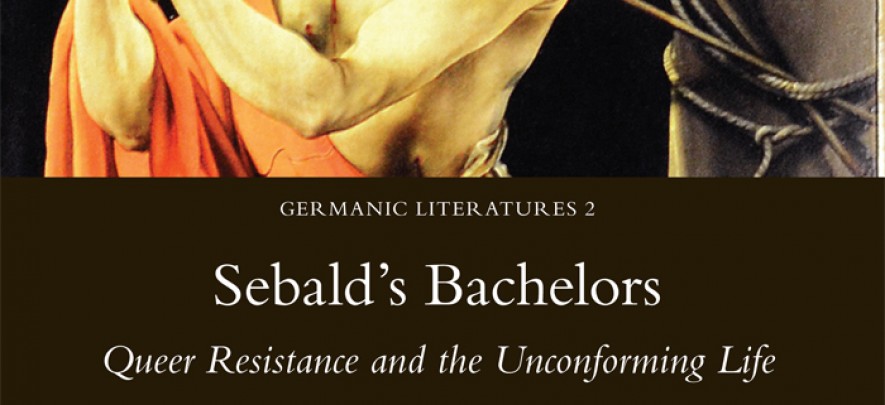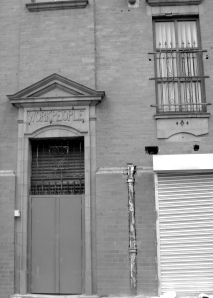One reason that I was happy to abandon our Sebaldian tour of Manchester before the Northern Manchester Jewish quarter was that I had already made a pilgrimage there some years ago, when I first moved to Manchester. Here’s what I wrote about my pilgrimage at the time.
One time, driving into the city through the north inner-city wasteland, I saw a sign for the Manchester Jewish Museum, and one grey moody Sunday I decided to visit. It’s in the old Sephardic synagogue, ten minutes’ walk north from here; full of relics of a lively Jewish community, complete, in that very British twentieth century fashion, with a flurry of self-improving organisations: schools, charitable organisations, amateur dramatic societies, working men’s clubs, all the trappings of a lost community life.
But Jewish Manchester hasn’t gone. I am sadly used to wandering around the Scheunenviertel in Berlin and its equivalents in other European cities, stumbling over the Stolpersteine and realising the extent of the lives and communities destroyed by the Nazis. Manchester, though, is still one of the Jewish cultural centres of Britain. So why was this area – Red Bank and Strangeways, as it is properly called – devastated, triste and empty where once it was full of working-class Eastern European Ashkenazis, Sephardic lords of industry and Gentile Mancunians besides? The guide at the museum explained that it had been designated a light industrial zone after the war, so the dwellings were pulled down.
“Didn’t the Jewish community feel attacked?” I asked, the forced resettlements and ethnic cleansings of Europe on my mind. “Oh no,” she said breezily, “people were upwardly mobile, and most of them had moved to the leafy suburbs already.” The same story, then, as with Dublin’s Little Jerusalem, where I used to live, which was full of Jewish immigrants in 1900 who had mostly become middle-class and moved to Terenure and similarly salubrious pastures by 1930. No tragic tale, then, just… rezoning. But Little Jerusalem is still an immigrant district, boasting Ireland’s first mosque, full of halal southern fried chicken shops and callshops and African hairdressers. One set of immigrants moves up in society, another moves in; it’s the multi-cultural urban dream, right? And the energetic clash of cultures and influx of new citizens keeps areas alive? Whereas this utter abandonment of a district within ten minutes’ walk of the city centre to shabby warehousing, import-export businesses and decaying surface carpark is baffling to me.
Armed with a map of the old Jewish Quarter, I wandered around the district, and realised that it’s not dead at all. There’s the Sikh temple, for one thing, and the erstwhile Red Bank is now brimming with independent businesses – car hire or storage warehouses, but mostly the rag trade, with Asian names and hard-nosed discounts on the signs stacked up on the frontages of a wild array of disreputable buildings. These range from corrugated iron shacks, brave 1990s one-story brick buildings to mouldering palaces of industry of indeterminate age. And among them are the lost Jewish buildings: that is, those that remain and haven’t been used and re-used until they’ve been condemned and replaced. I’m still bewildered by the mentality that sternly deems the area for industry only, not for dwellings or heritage or art or leisure, but that’s the learning experience of emigration for you. Andere Länder, andere Sitten. And hey, there’s always the inexorable onward march of buy-to-let apartmentland to revive the area, right? I didn’t find any lawyer’s office, with the names Glickmann, Grunwald and Gottgetreu on it, but this is what I found…

Archived/Talmud Torah School, Bent Street. Founded in 1894 for teaching Hebrew and religion to the poor. Still standing and in use, just; the upper windows have no glass, and trees are growing out of the roof

Ajaz Brothers Cash & Carry/ Jews' School, Derby St. Built 1869, with the aim to educate and anglicise eastern European Jews. The use of Yiddish was banned

Immigrant rag trade: B & A Fashions/ Marks & Spencer warehouse/headquarters, Derby Street. Russian Jewish immigrant Michael Marks built this warehouse as the headquarters of his partnership with Gentile Tom Spencer. It was M&S HQ until 1923

Jordash Ltd, Manufacturers, Importers and Wholesalers of Ethnic & Alternative Clothing/ New Synagogue, built by eastern European Jews in 1889

Asian Community Radio/ Philanthropic Hall, Empire Street. Jewish soup kitchen, offered free soup and food to workers in the local factories

Allwood Furniture/Central Synagogue, Cheetham Hill Road. I couldn't find a single trace on this building that revealed its former use as a place of worship, though the building is, of course, markedly more fancy than the majority of cheap furniture dealerships
Thanks are due to the Manchester Jewish museum for all information, particularly the guidebook to Jewish Manchester.




Not sure if you’ve met up with Bill Williams who is the historian of Jewish Manchester
He’s leading the morning session at this event
http://northernradicalhistory.wordpress.com/2012/08/17/the-3rd-northern-radical-history-network-meeting-saturday-6-october-2012-manchester/
I don’t know Bill Williams personally, but I’ve read his work – which helped to guide this post. I’d love to make it along on the tour, so thank very much for the link.